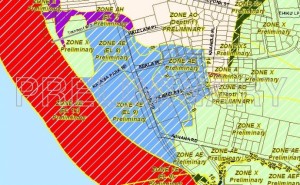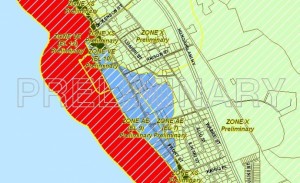New Flood Maps May Mean Higher Flood Insurance
By Sonia Isotov
A public meeting is to be held to assist residents and business owners in understanding the new flood map changes that will take effect later this year.
Residents can view the preliminary map revisions, understand how their properties may be affected, and learn about financial steps that they may take to protect their investment.
Property owners are urged to attend these meetings to get the latest information on how the flood map changes, scheduled to take effect on September 19, 2012, will affect them.
The public meeting will be held March 12 at the Hawaiian Islands Humpback Whale National Marine Sanctuary at 726 South Kihei Road from 4 p.m. to 7 p.m. A presentation will be made at 5:30 p.m.
Personnel from the Federal Emergency Management Agency (FEMA), the State of Hawaii’s Department of Land and Natural Resources, and the County of Maui’s Planning Department will be available to discuss the preliminary flood maps and to provide information on required construction standards and flood insurance availability.
Important information on the Federal Emergency Management Agency’s (FEMA) new digital flood insurance rate maps (DFIRMs), which integrate the statewide hurricane study, will be discussed.
With the adoption of the new DFIRMs for the islands of Maui and Lanai scheduled on September 19, 2012, a property’s flood risk may change. And consequently, so will the requirement for federally-mandated flood insurance as well as construction standards.
Flood insurance protects property owners from the financial devastation caused by floods, which includes losses to buildings and their contents. The coverage applies whether the flooding results from heavy or prolonged rains, coastal storm surge, tsunamis, blocked storm drainage systems, levee dam failure, or other causes. Different types of policies are available depending on your flood risk.
If you live in a high-risk area, flood zones A and V (see maps), you will need a Standard Policy. Most mortgage lenders will require that you have such a policy before they will approve your loan.
For those outside of the high-risk area, zones X or XS (see maps), flood insurance is also available, usually at a lower cost. A Preferred Risk Policy can cover both a home and its contents.
While you are not federally mandated to have flood insurance in a low-to-moderate risk area, it does not mean that you will never need it. Large floods often extend beyond the boundaries of high-risk areas and smaller floods occur outside high-risk areas as well. In fact, a quarter of all flood insurance claims come from properties located in low-to-moderate risk areas.
Properties currently within the low-to-moderate flood risk areas may be able to be grandfathered into a lower insurance premium if flood insurance is obtained prior to a property’s re-classification into a higher flood risk. You may log on to www.floodsmart.gov to view flood insurance premiums. Please contact your local insurance agent for specific information.
The public may view the new Digital Flood Insurance Rate Maps (DIRMs) by visiting the Hawai’i Flood Hazard Assessment Tool website, http://gis.hawaiinfip.org/fhat/
Additional meetings are anticipated to be scheduled in the next few months. For more information, please contact Francis Cerizo or Carolyn Cortez at [email protected] or [email protected] or by phone at (808) 270-7253.












